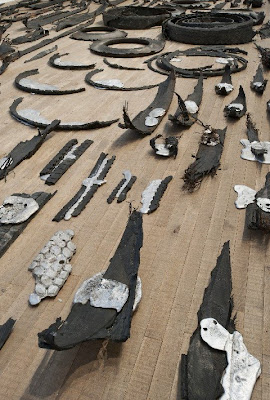Orozco gives found or discarded objects a new identity by transforming them. His found human skull which he has inscribed in a chequerboard pattern is a prime example of this.
I was particularly struck by his work entitled Lintels, 2001. At first glance, they appear to be a collection of fragile pieces of cloth hanging on washing lines. However, on closer inspection you learn that they are actually made of very familiar household waste, the lint formed of skin cells, hair and fabric that accumulates in domestic dryers. I was struck by their subtle colouring with random flecks of colour and their unusual amalgamation of spontaneous textures. They are more than fabric, they tell a narrative and their collective nature is truly representational of New York's multi-culturalism. The work was apparently first exhibited in New York post the 9/11 attacks. The ashen coloured traces of garments and lives made the work extremely emotive.
This work inspired me into investigating a potential use for this worthless, everyday, domestic leftover, which draws ones attention to the precariousness of human life. I would like to experiment with using lint as a growing medium in my current transition project as the laundry room in my halls of residence is frequently scattered with discarded lint.
The Yielding Stone struck me as an extraordinarily inventive way of documenting and recording a journey. The artist created a plasticine ball of his own weight and rolled it in the streets, allowing it to absorb all the imprints and debris along its journey through the city. The final object was representational of the artist’s self-portrait during that decade- constantly on the move, always receptive to new environments and experiences. During my transition project, I too will undergo a journey- perhaps not in the straightforward, physical way as expressed by the Yielding Stone but over the 8 weeks I will learn and gain several skills in Brockwell Community Gardens. Like Orozco, I will document the marks, lines and textures that I see along my way and these will influence my textile interpretation of this narrative.
Yielding Stone, 1992
‘First was the Spitting’ may have disgusted many viewers, but I thought it was a highly original and innovative way of exploring marks and the creation of spontaneous pattern. The series of graph paper pieces feature spat toothpaste as the starting point of a drawing, which is then expanded with small circles of ink and graphite. The compositions spread and grow, often resembling molecular diagrams or natural forms under a microscope. It is incredible ho w something so beautiful can grow from such a vulgar, non descript mark.
Orozco’s photography is also very striking and thought provoking. Some of his compositions are simply found, e.g. puddles intersecting a circle of wet bicycle tyre tracks, while others stem from the artist’s own modest intervention, e.g. a trace of his breath on the laquered surface of a piano
Pinched ball, 1993
The artist has found beauty in the everyday, unnoticed and drawn our attention to our surroundings through subtle observations. A prime example of this is the beautiful limescale covered shower head.
'Until you find another Yellow Schwalbe', 1995 is a photographic series, which responds to the artist’s time in Berlin. Orozco bought a yellow motorscooter and roamed the city looking for matching scooters, photographing the pair wherever they ‘met’. The different locations give the scooter a new context and allow us to perceive it differently.
Like Lintels, Chicotes is another sculpture created using old, discarded materials. It features scraps of rubber, burst tyre remnants which Orozco has gathered form along Mexican highways for years. Despite effectively being a ‘pile of old rubbish’ Orozco has succeeded in elevating debris to the status of sculpture which once again demands that viewers reassess their aesthetic responses to humble everyday materials and situations.

Chicotes 2010
This exhibition was thought-provoking and challenged excepted convention norms. I know that some of the materials chosen and techniques used will influence my future projects as ways of looking at thing in an unconventional manner.
My Hands Are My Heart 1991
La DS 1993
